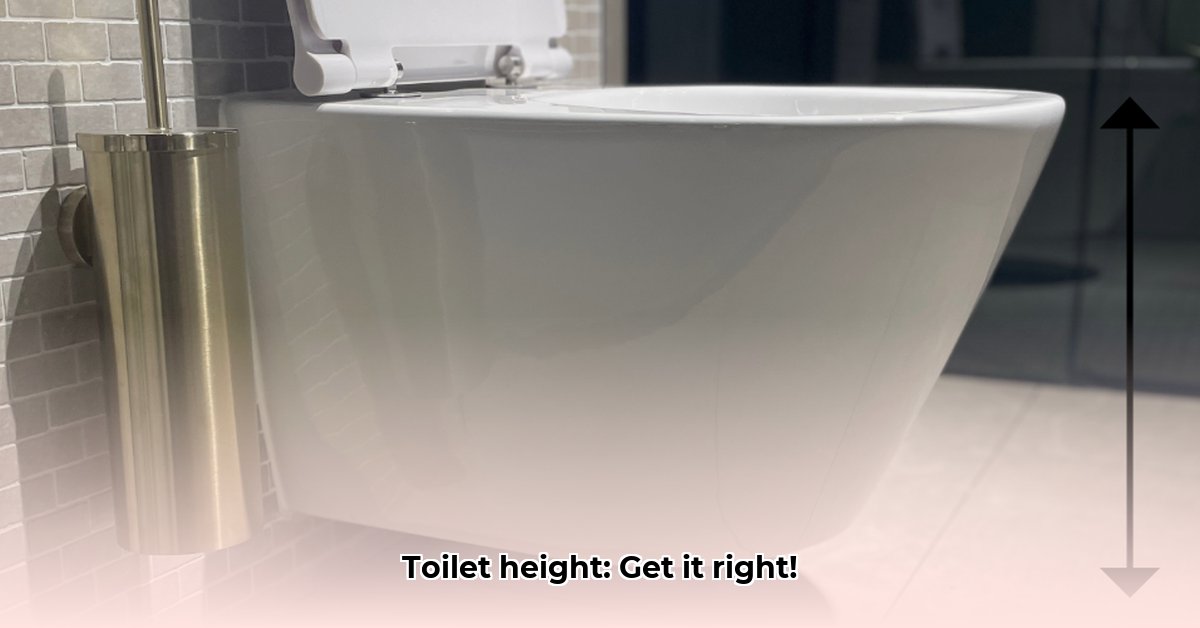
Choosing the right toilet height might seem like a small detail, but it significantly impacts comfort and safety, especially for older people or those with mobility challenges. This guide will walk you through selecting and installing the perfect loo for your home. We'll cover ideal heights for different age groups, essential measurements, and practical installation tips. Let's get started!
Standaard Hoogte Toilet: Finding the Perfect Fit
A comfortable toilet is more than just a functional fixture; it's a crucial element of bathroom safety and convenience. In South Africa, you'll typically find "standaard hoogte toiletten" advertised, usually ranging from 40 to 43cm in height. However, this standard isn't ideal for everyone. Let's explore how to find the perfect height for your household.
Understanding Toilet Heights: It's About More Than Just Numbers
The height of your toilet significantly impacts ease of use. A "comfort height" toilet (approximately 45-50cm) makes getting on and off much easier, particularly beneficial for seniors and individuals with mobility issues. Conversely, a standard-height toilet might be too tall for young children, potentially requiring a step stool. Before making a purchase, consider who will primarily use the toilet – are you prioritising universal comfort or tailoring the height to adults?
Measuring Up: The First Step to Toilet Bliss
Before you even browse, grab your tape measure! Measure your current toilet's height from the floor to the top of the bowl. This serves as a benchmark. Next, measure the seated height of the individuals who will regularly use the toilet. Ideally, a 90-degree bend in the knees when seated should be achieved to minimise strain. You spend considerable time on the loo, so comfort is paramount. Don't rush this step; accurate measurements are key to a comfortable and safe toilet experience.
Recommended Heights: A Quick Reference Guide
This table provides recommended toilet heights for different age groups:
| User Group | Recommended Height (cm) | Important Considerations |
|---|---|---|
| Toddlers (under 5) | 28-33 | Potty chairs or child-sized toilets are often more suitable. Step stools can help with slightly taller toilets. |
| Children (5-12) | 33-38 | Adjust as your child grows; you might need to replace the toilet eventually. |
| Adults (Average Height) | 40-43 | This is the typical "standard height" toilet. |
| Seniors/Disabled | 45-50 (Comfort Height) | Makes getting on and off easier and safer; reduces fall risk. |
Beyond Height: Factors to Consider
Height isn't the only factor. The bowl shape (elongated bowls generally offer more space) and the toilet seat's addition to the overall height should be considered. For elderly family members or anyone with mobility concerns, consider installing grab bars for enhanced stability and fall prevention. Always check local building regulations before undertaking plumbing or installation work. A well-chosen toilet is about more than just function – it's about safety and comfort. Have you considered the potential of adding a bidet function for increased hygiene?
Installation: Ensuring a Solid Foundation
Correct installation is vital, especially when altering toilet height. The toilet must be level and securely fastened to the floor. If you lack plumbing experience, hiring a qualified plumber is strongly recommended to ensure safe and correct installation. This step is crucial for preventing leaks and maintaining the toilet’s structural integrity. Did you know that improper installation can void warranties on certain models?
Making the Right Choice: Your New, Comfortable Throne
Choosing the right toilet height is a significant decision impacting comfort and safety for years to come. Considering the needs of all users and following these guidelines will ensure a worthwhile investment. It's not just functionality; it's creating a more enjoyable bathroom experience. Remember, a comfortable toilet can genuinely improve your quality of life!
How to Choose the Best Toilet Height for Seniors with Mobility Issues
Selecting the appropriate toilet height for seniors is crucial for their safety and independence. An improperly chosen toilet increases the risk of falls and injuries. Let's explore the process of selecting the perfect toilet for senior citizens.
Understanding Toilet Heights for Seniors
Standard toilet heights are typically around 40cm. However, "comfort height" toilets (45-50cm) significantly ease the process of sitting down and standing up for older adults. The additional height acts like a helping hand, reducing strain and improving safety. Yet, individual needs vary, so personalising your choice is key. A person's height, mobility and health conditions all play a role in the ideal toilet choice.
Measuring Your Needs: A Step-by-Step Guide
Before purchasing, follow these steps:
- Measure Your Current Toilet: Note the height of your existing toilet seat.
- Assess Height and Mobility: Consider the user's height and any mobility challenges.
- Consult a Professional: An occupational therapist can provide tailored recommendations.
- Explore Alternatives: Raised toilet seats or commode frames can offer immediate height adjustments.
- Check Dimensions: Carefully review the height, seat depth, and bowl shape (round or elongated) of potential new toilets.
Choosing the Right Toilet: Beyond Height
Beyond height, consider:
- Shape: Elongated bowls generally offer more space and support.
- Grab Bars: Install sturdy grab bars for extra stability near the toilet.
- Non-Slip Surfaces: Opt for a toilet seat with a non-slip surface to prevent falls.
- Features: Additional features such as heated seats or bidet functions enhance comfort.
Alternative Solutions: Raised Toilet Seats and Commode Frames
If replacing a toilet is impractical, raised toilet seats or commode frames offer quick and convenient height increases, providing immediate support and improved comfort.
Key Takeaways:
- Height is crucial: The correct toilet height substantially improves safety and comfort for seniors.
- Personalise your choice: Consider the individual’s height, mobility, and health conditions.
- Explore alternatives: Raised seats and commode frames offer simple solutions.
- Seek professional advice: Occupational therapists provide valuable guidance.